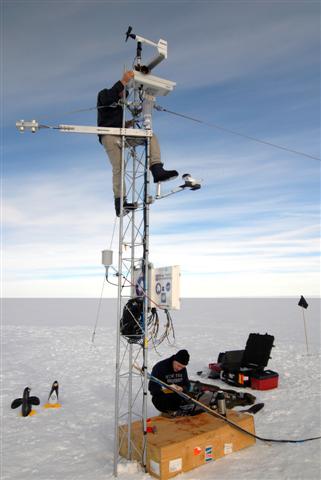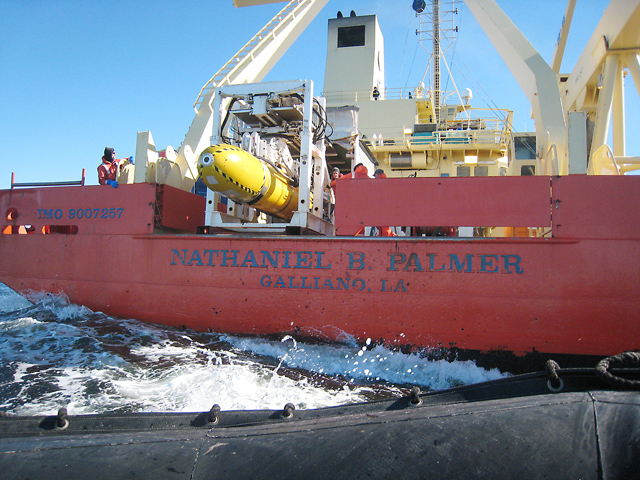IPY made large-scale, deep-field projects possibleThe World Meteorological Organization (WMO) The 16-page report said: “New assessments of the state of the Greenland and Antarctic ice sheets have been made using novel techniques. These include satellite measurements of changes to the elevation and the gravitational fields of the ice sheets. … These assessments continue to be refined, but it now appears certain that both the Greenland and the Antarctic ice sheets are losing mass and thus raising sea level, and that the rate of ice loss from Greenland is growing.” The ocean appears to play an active role in ice melt. A project led by Stan Jacobs 
Photo Credit: Cliff Leight/Antarctic Photo Library
Weather instruments and a GPS are placed on ice near Pine Island Glacier, one of the fastest moving glaciers in Antarctica.
The ocean-ice shelf interaction is another important variable as the science community attempts to calculate sea-level rise, with recent reports estimating a one meter increase by century’s end. “My expectation is that this cruise collected a lot of data to advance understanding of that process, but I haven’t seen the data sets yet,” Borg said. One expectation is that the spirit of IPY — the broad international cooperation it fostered — will live well past this month. In light of the current global recession and the increasing cost and scope of polar research, it seems collaboration between nations must continue. That’s the conclusion Tom Neumann, expedition leader of the second leg of a joint Norwegian-U.S. IPY Traverse “This project has been carried out in the true spirit of the International Polar Year,” Neumann wrote on the expedition’s Web site dated Feb. 23. “Neither the U.S. nor Norway could have completed this project, either scientifically or logistically, on their own. Our collaboration has been the key feature of this project.” Ted Scambos “I think one of the main legacies of IPY is that it really opened up East Antarctica. We knew some things about East Antarctica from [the IGY], the earlier traverses through the 1960s, but we didn’t know a whole lot.” The Norwegian-U.S. IPY Traverse, for instance, will add new details to the climate record of East Antarctica from the last millennium. The traverse scientists also mapped out a region of subglacial lakes called the Recovery Lakes. And AGAP, ICECAP and other projects all contributed to a more robust understanding of East Antarctica, which contains enough ice to raise sea level by 60 meters should it all melt. (An unlikely scenario for thousands of years.) “All of that puts East Antarctica into the same league as West Antarctica in terms of understanding what kind of player it is in the ocean-ice system,” Scambos said. Borg said he anticipated more logistically challenging projects in the future, but said the NSF had not funded anything specific at this time. “We do have active interest in collaborating in new ice-coring sites in the near future,” he said. “And I’m sure things like AGAP will come along in future.” The report from the WMO and ICSU stressed the need for further research into the Antarctic and Arctic, based on the findings from IPY. “The polar regions are an integral and rapidly changing part of the Earth system. Humankind’s future environment, well-being and sustainable development require that we comprehensively understand and observe polar systems and processes and the changes that are already upon us,” the report concluded. “The message of IPY is loud and clear: what happens in the polar regions affects the rest of the world and concerns us all.” |



For USAP Participants |
For The Public |
For Researchers and EducatorsContact UsU.S. National Science FoundationOffice of Polar Programs Geosciences Directorate 2415 Eisenhower Avenue, Suite W7100 Alexandria, VA 22314 Sign up for the NSF Office of Polar Programs newsletter and events. Feedback Form |


